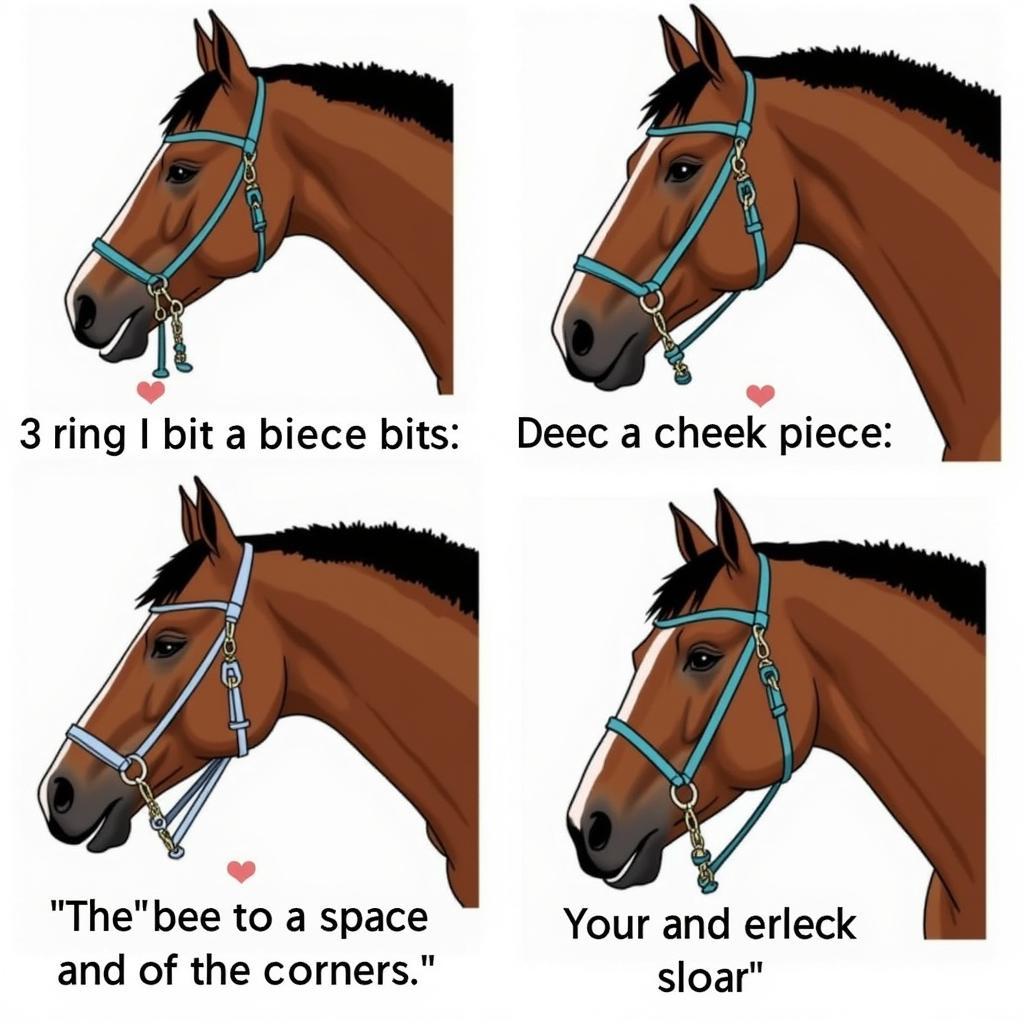3 Ring Horse Bits are a popular choice among riders, offering versatility and control. But what exactly makes them unique, and how do you choose the right one for your horse? This comprehensive guide will delve into the intricacies of 3 ring bits, exploring their various types, benefits, and proper usage. We’ll cover everything you need to know to make an informed decision and ensure a comfortable and effective riding experience for both you and your equine partner.
Decoding the 3 Ring Horse Bit: Types and Functionality
The 3 ring bit, also sometimes referred to as an O-ring bit, gets its name from the three rings attached to the mouthpiece. These rings provide multiple rein attachment points, allowing for varying levels of pressure and control. The most common types include:
-
Loose Ring 3 Ring Bit: These bits offer more movement in the horse’s mouth, encouraging relaxation and acceptance. The loose rings can also help prevent pinching of the lips.
-
Eggbutt 3 Ring Bit: The eggbutt cheek pieces are fixed to the mouthpiece, providing a more stable feel and less lateral movement. This type is often preferred for horses that tend to fuss with the bit.
-
D-Ring 3 Ring Bit: The D-shaped rings offer a balance between stability and mobility. They provide more lateral control than loose rings but less than eggbutts.
Understanding the different cheek piece styles is crucial as it directly impacts how the bit communicates with the horse.
Benefits of Using a 3 Ring Horse Bit
Why choose a 3 ring bit over other types? Several benefits make them a popular option:
-
Versatility: The multiple rein positions allow riders to adjust the level of control and pressure, making these bits suitable for a variety of disciplines and training levels.
-
Control: When used correctly, 3 ring bits can offer precise communication and aid in refining a horse’s responsiveness to rein cues.
-
Comfort (Potential): Depending on the mouthpiece and how the bit is adjusted, 3 ring bits can be comfortable for many horses. However, improper use can lead to discomfort and even pain.
Remember, a bit’s effectiveness depends heavily on the rider’s skill and understanding of how it functions. Misuse can negate any potential benefits.
Choosing the Right 3 Ring Bit for Your Horse
Selecting the appropriate bit requires careful consideration of your horse’s individual needs and your riding style. Factors to consider include:
-
Horse’s Experience and Temperament: A younger or more sensitive horse might benefit from a loose ring or eggbutt 3 ring bit, while a more experienced horse may be comfortable with a D-ring. For a horse that’s not eating their grain, but is still consuming hay, you might want to check out this helpful resource: horse not eating grain but eating hay.
-
Riding Discipline: The demands of different disciplines influence bit choice. For example, a horse participating in dressage may require a different bit than one used for trail riding. If you’re looking for fancy horse bridles to complement your bit, explore our selection here: fancy horse bridles.
-
Mouth Conformation: Horses with low palates or thick tongues may require a bit with a specific mouthpiece shape to avoid discomfort. You may also want to consider the Argentina bit horse, known for its comfortable design. Find out more about it here: argentina bit horse.
-
Rider’s Skill Level: A rider’s experience and ability to use the bit correctly are crucial for the horse’s comfort and well-being.
Common Misconceptions about 3 Ring Bits
Some riders believe that 3 ring bits are inherently harsh. However, this isn’t necessarily true. Like any bit, the severity of a 3 ring bit depends on the rider’s hands and how it’s used. Using the top ring as a leverage point can create significant pressure, while using the lower rings can offer a milder action. It’s also important to know how to react when your horse on the floor.
“A well-fitting 3 ring bit in the hands of a skilled rider can be a valuable tool for communication,” says equine expert, Dr. Amelia Carter. “However, improper use can cause discomfort and confusion for the horse.”
 Proper 3 Ring Bit Adjustment
Proper 3 Ring Bit Adjustment
Another common misconception is that 3 ring bits are only for experienced riders. While it’s true that using them effectively requires understanding, novice riders can benefit from their versatility under the guidance of a qualified instructor.
Conclusion
3 ring horse bits offer a range of benefits for both horse and rider. By carefully considering your horse’s individual needs and your riding style, you can choose the right 3 ring bit to enhance communication and improve your riding experience. Remember, proper usage and adjustment are essential for ensuring your horse’s comfort and well-being. A well-chosen and correctly used 3 ring bit can be a valuable asset in your riding journey. Looking for natural remedies for your horse? Consider exploring natural antihistamines: natural antihistamine for horses.
FAQ
- What are the different types of 3 ring bits?
- What are the benefits of using a 3 ring bit?
- How do I choose the right 3 ring bit for my horse?
- Are 3 ring bits harsh?
- Can beginners use 3 ring bits?
- How do I properly adjust a 3 ring bit?
- What are some common misconceptions about 3 ring bits?
For any further assistance, please contact us at Phone: 0772127271, Email: [email protected] or visit us at QGM2+WX2, Vị Trung, Vị Thuỷ, Hậu Giang, Việt Nam. We have a 24/7 customer service team.